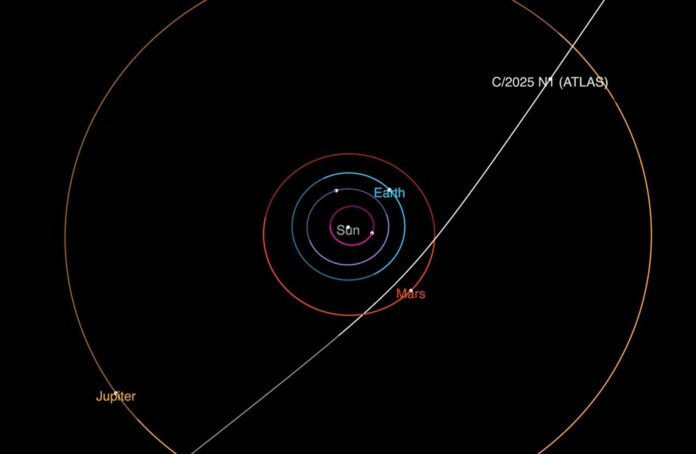Our Solar System has welcomed its third confirmed interstellar visitor, a massive comet designated 3I/ATLAS that’s currently racing through space at extraordinary speeds. Astronomers confirmed the discovery of this interstellar object on June 2, 2025, making it only the third ever spotted racing through our solar system.
The cosmic visitor, initially cataloged as A11pI3Z before receiving its official designation, represents a groundbreaking discovery that’s capturing worldwide attention. The interstellar comet is speeding through the solar system at 221,000 km/h, following an extreme hyperbolic trajectory that ensures it will never return once it leaves our cosmic neighborhood.
Table of Contents
Unprecedented Size and Characteristics
What makes 3I/ATLAS particularly remarkable is its impressive size compared to previous interstellar visitors. The visitor from the stars is likely the largest yet detected and has been classified as a comet, or cosmic snowball. This discovery challenges astronomers’ expectations about interstellar object populations.
The NASA-funded ATLAS (Asteroid Terrestrial-impact Last Alert System) survey telescope in Rio Hurtado, Chile, first reported observations on July 1, marking the beginning of intensive worldwide observation campaigns.
Key Points Summary
- Third confirmed interstellar object ever discovered
- Traveling at 221,000 km/h through space
- Largest interstellar visitor detected to date
- Classified as a comet with fuzzy appearance
- Following hyperbolic trajectory – won’t return
- First spotted by ATLAS telescope in Chile
Scientific Significance and Observations
These visitors from faraway regions of the cosmos are valuable objects to study since they offer a tangible connection to other star systems, carrying information about the chemical elements that were present when and where they formed. This provides scientists unprecedented insights into planetary system formation across our galaxy’s history.
The JWST made its first observations of 3I/ATLAS using its NIRSpec instrument on August 6, 2025, although the data will not be released to the public until 3 months after. These observations promise to unlock secrets about the comet’s composition and origin.
Journey Through Our Cosmic Neighborhood
The interstellar comet follows a fascinating path through our Solar System. When 3I/ATLAS entered the Solar System, it was moving at a speed of 58 km/s relative to the Sun—this speed is the comet’s hyperbolic excess velocity. As it approaches our star, gravitational forces will accelerate it further before it slingshots back into interstellar space.
Unlike periodic comets that originate within our Solar System, 3I/ATLAS carries material forged in distant stellar environments. Its composition may reveal clues about star formation processes in remote regions of the Milky Way, potentially from systems that no longer exist.
Implications for Planetary Defense
While 3I/ATLAS poses no threat to Earth, its discovery highlights the importance of continuous sky monitoring programs. The detection capabilities demonstrated by ATLAS and other survey systems prove crucial for identifying both potentially hazardous objects and scientifically valuable visitors from beyond our Solar System.
Scientists estimate that many more interstellar objects likely pass through undetected, suggesting our cosmic neighborhood receives regular visitors from distant star systems. Enhanced detection methods may reveal a hidden population of these cosmic wanderers.
Looking Forward
As 3I/ATLAS continues its journey through our Solar System, astronomers worldwide maintain intensive observation schedules. The comet represents a once-in-a-lifetime opportunity to study pristine material from another stellar system, offering unprecedented insights into the broader cosmos.
This remarkable visitor reminds us that our Solar System exists within a dynamic galactic environment, where objects regularly traverse the vast distances between stars. What discoveries do you think future interstellar visitors might bring to our understanding of the universe?
